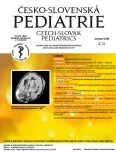Intracranial haemorrhage in patients with haemophilia A
Authors:
O. Zapletal; J. Blatný; P. Ovesná 1; V. Komrska 2; T. Pavlíková 3; S. Köhlerová; Čnhp V. Jménem Center Spolupracujících V Rámci Fiamoli 4
Authors‘ workplace:
Oddělení dětské hematologie Fakultní nemocnice Brno, Centrum komplexní léčby hemofilie
; Institut biostatistiky a analýz Masarykovy univerzity, Brno
1; Klinika dětské hematologie a onkologie 2. LF UK a FN Motol, Praha
2; Klinika dětské radiologie Fakultní nemocnice Brno
3; Český národní hemofilický program (http://cnhp. registry. cz)
4
Published in:
Čes-slov Pediat 2019; 74 (4): 233-239.
Category:
Original Papers
Overview
Objective: The aim of this survey was to find out incidence and other circumstances of CNS bleeding in patients with haemophilia A in the Czech Republic.
Methods: Data from Czech National Haemophilia Program (CNHP) registry were evaluated. The findings were compared with available published evidence. Three case reports of CNS bleeding in newborns with haemophilia A are also presented.
Results: CNS bleeding is very rare in patients with haemophilia in Czech Republic – about one out of 1000 bleeding episodes. Patients at any age can be affected, though; bleeds reported between 0 to 79 years. Up to 5% of newborns with haemophilia A may experience CNS bleeding.
Conclusions: CNS bleeding is rare, but serious manifestation of haemophilia. Clinical manifestation and sequels can be various, from mild to fatal, as demonstrated in case reports. Diagnosis has to be done quickly and proper therapy including factor FVIII substitution should be immediately initiated. Diagnostics and treatment shall be done only in adequately equipped Haemophilia centre (HTC – Haemophilia Treatment Centre or CCC – Complex Care Centre)..
Keywords:
haemophilia – brain bleeding
Sources
1. Lee Ch A, et al. Textbook of Hemophilia. 2nd ed. Wiley-Blackwell, 2010: 110–114. IBSN 978-4051-6914-1.
2. Tarantino MD, et al. The incidence and outcome of intracranial hemorrhage in newborns with hemophilia: Analysis of Nationwide Inpatient Sample database. Haemophilia 2007; 13: 380–382.
3. Davies J, et al. Mode of delivery and cranial bleeding in newborns with haemophilia: a systematic review and meta-analysis of the literature. Review. Haemophilia 2016 Jan; 22 (1): 32–38. doi: 10.1111/hae.12726. Epub 2015 May 20.
4. Stieltjes N, et al. Intracranial haemorrhages in French haemophilia patients (1991–2001): clinical presentation, management and prognosis factors for death. Haemophilia 2005; 11: 452–458.
5. Kletzel M, et al. Postdelivery head bleeding in hemophilic neonates. Arch J Dis Child 1989; 143: 1107–1110.
6. Revel-Vilk S, et al. Effect of intracranial bleeds on the health and quality of life of boys with hemophilia. J Pediatr 2004; 144: 490–495.
7. Richards M, et al. Neonatal bleeding in haemophilia: a European cohort study. Br J Haematol 2012; 156: 374–382.
8. Klinge J, et al. Prevalence and outcome of intracranial haemorrhage in haemophiliacs–a survey of the paediatric group of the German Society of Thrombosis and Haemostasis (GTH). Eur J Pediatr 1999; 158 (Suppl 3): S162–S165.
9. Whitby EH, et al. Frequency and natural history of subdural haemorrhages in baibies and relation to obstetric factors. Lancet 2004; 363: 846–851.
10.Kulkarni R, et al. Perinatal management of newborns with hemophilia, Br J Hematol 2001; 112: 264–274.
11. Gouw SC, et al. Treatment-related risk factors of inhibitor development in previously untreated patients with hemophilia A: the CANAL cohort study. Blood 2007 Jun 1; 109 (11): 4648–4654. Epub 2007 Feb 8.
12. http://www.ukhcdo.org/wp-content/uploads/2017/01/ITI-protocol-2017.pdf.
Labels
Neonatology Paediatrics General practitioner for children and adolescentsArticle was published in
Czech-Slovak Pediatrics

2019 Issue 4
Most read in this issue
- Specific aspects of posttraumatic stress disorder in childhood and adolescence
- Psychiatric disorders with predominance of somatic symptoms in childhood and adolescence
- Possibilities of pharmacotherapy of depressive disorder in children and adolescents
- The role of maternal autoantibodies in the pathogenesis of autism spectrum disorders
